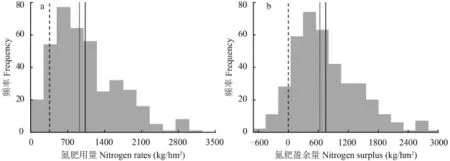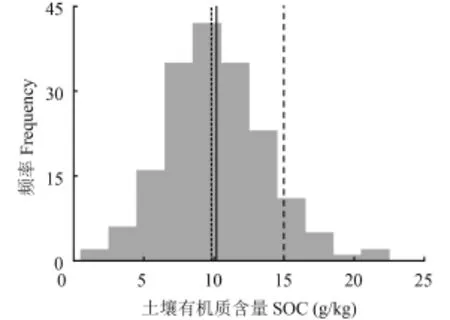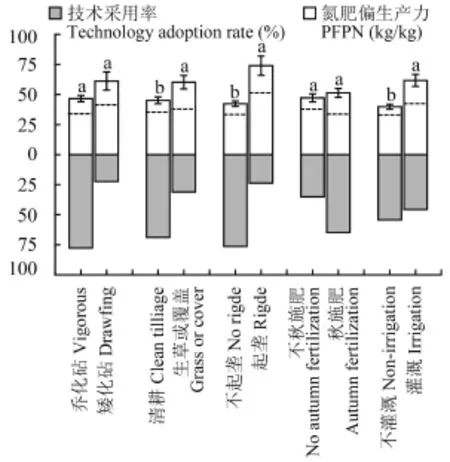黄土高原苹果过量施氮因素分析
2017-04-14赵帅翔张卫峰姜远茂张福锁
赵帅翔,张卫峰*,姜远茂,张福锁
(1 中国农业大学资源与环境学院,北京 100193;2 山东农业大学园艺科学与工程学院,泰安 271018)
黄土高原苹果过量施氮因素分析
赵帅翔1,张卫峰1*,姜远茂2,张福锁1
(1 中国农业大学资源与环境学院,北京 100193;2 山东农业大学园艺科学与工程学院,泰安 271018)
【目的】黄土高原苹果氮过量施用现象普遍,了解其主要影响因素有利于指导果园科学施肥,提高氮肥利用效率,保障苹果产业可持续发展,推进化肥用量零增长目标实现。【方法】通过对黄土高原苹果优势区进行调研和取土,收集了 2012~2013 年苹果产量、收购价格、氮肥用量、生产管理技术和 2013~2014 年的果园土壤有机质含量等指标数据,分别从苹果市场、土壤质量和配套技术采用三个方面对影响黄土高原苹果过量施氮的因素进行了论述,分析了氮肥用量对苹果产量和果实大小 (收购价格) 的影响,果园土壤有机质含量对氮肥用量的影响,不同生产管理技术下的果农采用率和氮肥偏生产力 (PFPN) 差异。【结果】当前黄土高原苹果氮肥用量大,中位数和算术平均值分别为 921 kg/hm2和 (1032 ± 32) kg/hm2,氮肥过量施用的果农比例高达 90% 以上。果园土壤有机质含量低,中位数和算术平均值分别为 9.8 g/kg 和 (10.2 ± 0.3) g/kg,远低于我国丰产优质果园有机质含量标准 (> 15 g/kg)。随着氮肥用量的增加,苹果产量没有受到显著影响,而果实大小 (收购价格) 却与其显著正相关。随着果园土壤有机质含量的不断降低,果农氮肥用量呈上升趋势,但未达到显著水平 (原因是果园有机质普遍较低,区组间差异较小)。不同生产管理技术间的果农采用率差异较大,其中减氮增效配套技术的采用率普遍低于其他技术。果农间减氮增效配套技术应用效果差异大、技术到位率 (正确的应用方式) 低。【结论】苹果市场偏爱大果、果园土壤质量低、减氮增效配套技术普及不足是影响黄土高原苹果过量施氮的重要因素。因此,建立苹果品质评价体系并引导农户,加快果园提质工作的开展,加强减氮增效配套技术的推广力度,是今后我国苹果减氮增效工作的重点方向。
黄土高原;苹果;过量施氮;因素分析
我国已成为世界上最大的苹果生产国。最新统计数据显示,2013 年我国苹果面积达 240 万公顷,总产量约 4000 万吨,分别占世界苹果总面积和总产量的 46 % 和 49 %[1]。然而,我国苹果氮肥用量高,平均为 400~600 kg/hm2[2],是发达国家苹果氮肥用量[3](100~150 kg/hm2) 的 4~5 倍。氮肥利用率 (REN)低,我国平均为 25%,远低于发达国家的 40%[4],氮过量施用果农比例高达 70%,并呈逐年增加的趋势[5]。氮肥过量施用,使我国苹果品质与国外发达国家相差甚远。从优质果率和高档果率来看,我国苹果分别不足 40% 和 5%,而美国、新西兰都分别达到70% 和 50% 以上[6]。果实品质低,很难打破许多发达国家的技术性贸易壁垒 (如日本的“肯定列表制度”,北欧四国的“白天鹅制度”,欧盟的“EU 制度”),增加了我国苹果出口的难度,不利于我国国际贸易的扩大和苹果产业的长足发展[7]。另外,氮肥过量施用不但会直接导致氮肥利用率的降低,还会间接带来一系列生态环境风险。例如氮沉降增加、温室效应加剧、土壤酸化、果树病害增加等[8-11]。鉴于此,我国于 2015 年提出了《到 2020 年化肥使用量零增长行动方案》[12]。我国苹果氮肥用量占全国氮肥总量的 3%,而且对氮肥增长的贡献大,近十年来苹果氮肥增加量 (47 万吨) 占全国氮肥总增加量 (457万吨) 的 10%[13]。因此,探究苹果氮肥过量施用的原因对于减缓我国苹果氮过量现状,保障我国苹果产业可持续发展、加快推进化肥用量零增长目标的实现具有重要意义。
尽管已有多个研究评价了果园施肥水平[14-15],但对于过量施氮的因素探究很少,制约了果园科学施肥技术和管理的发展。与粮食作物不同,果树作物经济价值高,果农为规避风险,在进行肥料投入时受肥料价格影响不大,如史恒通等[16]在研究苹果施肥投入结构影响因素时指出,化肥价格上涨并不会显著影响果农施肥量,主要因为施用化肥是提高产量最直接有效的途径之一。为获得收益最大化,肥料投入受苹果市场影响较大,如赵佐平等[17]在研究果园氮素投入特点时指出,果农施肥量与当年苹果价格存在一定正向关系。我国果园土壤质量低,有机质含量平均在 1% 左右[18]。土壤有机质贫瘠导致土壤肥力退化,直接影响化肥利用率、果树生长、产品质量提高[19]。果树是多年生园艺作物,栽培技术措施可显著影响养分利用效率。例如,与清耕相比,采用生草技术,可明显改善果园土壤理化性质,增加土壤有机质及矿质养分含量,提高矿质养分的利用效率,促进果树生长发育[20];与乔化砧相比,矮化砧类型的果树叶片和果实具有更高的养分含量,同时单果重、可溶性固形物和可滴定酸含量更高[21];在养分管理技术方面,与不秋施肥相比,采用秋季施肥技术的果园,可显著增加树体贮藏营养,利于翌年花芽分化,果实生长,利于养分的高效利用[22]。
因此,本研究通过果园调研,在明确黄土高原苹果生产现状的基础上,分别从苹果市场、土壤质量和配套技术采用三个方面对影响黄土高原果园氮肥过量施用的因素进行了系统的论述,以期对我国苹果科学施肥发展提供参考。
1 材料与方法
1.1 研究区域与品种
以黄土高原作为研究区域,主要原因有两点:第一,黄土高原是我国两大苹果优势产区之一 (另一个为环渤海湾),由于得天独厚的土壤气候优势,其苹果面积和产量逐年增加,目前已占到全国苹果总面积和总产量的 57% 和 52%[23];第二,黄土高原优势主产区果农过量施氮现象明显。以陕西省为例,2001 年氮过量果农比例为 50%[24],2009 年高达 84%[5]。以富士系列作为研究对象,主要因为富士系列是我国苹果主栽品种,约占全国苹果总面积的 70%[25]。
1.2 数据采集与描述
研究数据采集于黄土高原苹果优势产区内的 387个苹果园,覆盖陕西洛川、礼泉、乾县、兴平、长武,甘肃泾川,山西临猗,河南灵宝 4 个主产省 8个生产大县 (除兴平和长武外,每一个县的苹果面积均超过 2 万公顷) (图 1),在每个县根据农户收入水平选择了 4~5 个乡镇,每个乡镇选择 2~3 个村,每个村根据农户花名册随机选择 3~5 个果园。数据包括调研数据和土壤数据两部分,前者主要通过与果农面对面交流和后期电话回访的方式来获得,后者主要通过果园取土和室内化验的方式来获得。取土和化验方法分别为每个苹果园随机选取 12 株树,在每株树树冠投影处选取 6 个点,采集 0—40 cm 土层土壤,混合后按四分法取样[4],样本自然风干后,有机质采用重铬酸钾容量法测定[26]。调研过程中并没有对每个果农都同时进行问卷调研和果园取土,但样本分布基本能覆盖研究区域,剔除无效样本,最终得到 385 个问卷和 178 个土壤样本。

图1 调研样本县分布Fig. 1 Distribution of sampled counties in the research
调研实施时间为 2014 年 7~8 月,调研数据的时间范围为 2012 年果实采收后到 2013 年采收后,主要内容包括砧木类型、树龄、产量、收购价格、土壤管理基本情况 (例如:生草、起垄等) 和肥水管理基本情况等。土壤样本采集时间为 2014 年 7 月中旬,主要分析内容为土壤有机质含量 (soil organic matter content,SOC)。本研究苹果树龄在 8~30 a间,平均为 17 a,其中 10~25 a 的占 76%。
1.3 数据处理与分析
本研究中的苹果氮肥用量指的是化肥氮用量,通过化肥用量与其中的氮素含量相乘获得。本研究没考虑有机肥氮,主要因为有机肥氮用量小 (本研究中有机氮投入不足化肥氮用量的 5%)。探究氮肥用量与果实大小关系时,以收购价格作为果实大小的评判指标,主要因为目前我国苹果市场主要以果实大小作为收购标准,果实大小与收购价格呈显著正相关[27]。探究氮肥用量与 SOC 关系时,用到的 SOC 指标(2014 年) 与氮肥用量指标 (2013 年) 时间尺度有所不同,然而并不影响最终结果的定性研究,主要因为黄土高原果园 SOC 变化慢,相邻两年差异不显著[28]。本研究以氮肥偏生产力 (PFPN) 作为配套技术的减氮增效评价指标,计算公式如下:

研究结果以中位数和算术平均值 (± 标准误差)两种形式进行表达,主要因为果农间氮肥用量差异大,仅以算术平均值表达代表性不强[29]。
研究中使用 Microsoft Excel 2003 软件进行数据处理,使用 ORIGIN 8.6 软件进行制图,使用 SPSS 16.0 软件进行单因素方差分析 (ANOVA) 及 t 检验。
2 结果与分析
2.1 黄土高原苹果氮肥用量与氮过量现状
黄土高原苹果氮肥用量大,中位数和算术平均值分别为 921 kg/hm2和 (1032 ± 32) kg/hm2(图 2a),比2013 年全国苹果氮肥平均用量 (490 kg/hm2) 高 111%[13],远高于发达国家苹果氮肥用量 (100~150 kg/hm2)[3]。

图2 氮肥用量和氮肥盈余量频率分布Fig. 2 The frequency distribution of nitrogen fertilizer rate and the surplus of nitrogen [注(Note):垂直长虚线表示氮肥施用评价标准,垂直短虚线示中位数,垂直实线表示算术平均数 The long vertical dashed lines represent the evaluation for the nitrogen application, the short vertical dashed lines represent the median, and the vertical solid lines represent the mean. n = 385.]
以 苹 果 规 范 管 理 技 术 推 荐 施 氮 标 准[30](每 生 产100 kg 苹果,化肥氮用量为 0.8 kg) 分析黄土高原苹果果农施氮情况 (图 2b),发现果农氮过量现象十分严重。果园氮肥盈余量非常大 (氮盈余 = 化肥投入-果实带走-枝叶带走),中位数和平均值分别为633 kg/hm2和 (746 ± 33) kg/hm2,氮肥过量施用 (即盈余量大于 0 kg/hm2) 的果农比例为 92%。同时以黄土高原苹果专家推荐施氮标准[5]对果农施氮情况进行分析 (即氮肥投入大于 360 kg/hm2作为过量) (图 2a),氮肥过量施用的果农比例为 91%。两种标准下的黄土高原氮过量果农比例相似,均高达 90% 以上。
2.2 黄土高原果农过量施氮原因分析
2.2.1苹果市场偏爱大果 由于我国苹果果农收入与产量和收购价格紧密相关,在一定范围内,收购价格又与果实大小直线相关[27],因此产量和果实大小就构成了果农收益的关键因素。我们将氮肥用量划分为从低到高五个等级,其中氮肥用量小于或等于 375 kg/hm2的样本量为 41 个,占样本总量的 11%,在 375~750 kg/hm2的样本量为 110 个,占样本总量的 29%,在 750~1125 kg/hm2的样本量为 96 个,占样本总量的 25%,在 1125~1500 kg/hm2的样本量为 49 个,占样本总量的 13%,大于 1500 kg/hm2的样本量为 89个,占样本量的 23% (图 3)。进一步分析了氮肥用量与苹果产量以及果实大小 (收购价格) 的关系,发现苹果产量并没有显著受到氮肥用量的影响,氮肥用量超过 1125 kg/hm2后,苹果产量反而有下降趋势,可能原因是氮肥大量施用造成果树枝条旺长,生殖生长受到限制,进而大大降低了果树的负载量,影响最终苹果产量[31]。但果实大小 (收购价格) 却与氮肥用量成正相关,随着氮肥用量的增加,果实大小(收购价格) 不断提高,当氮肥用量超过 1500 kg/hm2时,果实大小 (收购价格) 才略有降低,可能此时氮肥用量过高,造成了果树营养元素吸收不平衡 (如抑制对钙的吸收),严重影响到果实品质,最终影响到收购价格[32]。另外,果实过大,超过优质果标准,价格也会降低。分析绝大多数果农过量施氮 (图 2) 的原因是氮肥大量施用可以显著增加果径,提高收购价格,进而增加经济效益。

图3 不同施氮区间下的苹果产量及果实价格Fig. 3 Fruit purchase price and yield under different nitrogen application ranges[注(Note):水平虚线表示中位数,不同小写字母表示在 P < 0.05 下达到显著性差异 The horizontal dotted lines represent the median, and different small letters mean significantly different within column at P <0.05 level. 图中误差棒是标准误差值 Error bars show SE. n = 385.]
2.2.2果园土壤质量低 长期以来我国果园建设以“上山下滩,不与粮棉争地”作为方针,多选用瘠薄土壤,果园立地条件较差,同时肥源少,果园有机肥投入不足,土壤质量偏低的问题非常突出。2014 年所测试样本果园 SOC 含量的中位数和算术平均值分别为 9.8 g/kg 和 10.2 g/kg,与 2012 年[33]相比,黄土高原果园 SOC 含量下降了 14%,远低于发达国家果园 SOC 的含量如日本[34](30~50 g/kg)。在本研究中的 385 个果园中,大于我国丰产优质果园有机质含量标准 (> 15 g/kg) 的果园比例仅为 9.6% (图 4)。
果园 SOC 是果树生长的重要肥力保障[35]。我国果园 SOC 含量低,土壤保肥能力差,为获得较高产量,果农氮肥用量往往较高。如图 5 所示,随着果园 SOC 含量的不断降低,果农氮肥用量呈上升趋

图4 果园土壤有机质含量频率分布Fig. 4 The frequency distribution of orchard soil organic matter contents[注(Note):垂直长虚线表示丰产优质果园 SOC 评价标准,垂直短虚线表示中位数,垂直实线表示算术平均数 The long vertical dashed line represents the evaluation standard of good harvest and high quality orchard SOC, the short vertical dashed line represents the median, and the vertical solid lines represent the mean. n = 178.]

图5 不同果园有机质含量区间下的氮肥投入Fig. 5 The nitrogen fertilizer rates under different organic matter contents in orchards[注(Note):水平实线表示中位数,水平虚线表示算术平均数The horizontal solid line represents the median, and the horizontal dotted line represents the mean;不同小写字母表示在 P < 0.05 下达到显著性差异 Different small letters mean significantly different at P <0.05 level. n = 178.]
势,但未达到显著水平 (原因是果园有机质普遍较低,区组间差异较小)。当 SOC 含量≤5 g/kg 时,氮肥用量最高,中位数和算术平均值分别为 1084 kg/hm2和 1100 kg/hm2。当有机质含量 > 15 g/kg 时,氮肥用量最低,中位数和算术平均值分别为 737 kg/hm2和 868 kg/hm2,相比于 SOC≤5 g/kg 的果园,氮肥用量中位数和算术平均值分别下降了 32% 和 21% (图 5)。
2.2.3果园减氮增效配套技术普及不足 黄土高原果园减氮增效配套技术普及不足,是造成果园大量施用氮肥的另一重要原因。结合果农生产现状 (如水肥一体化技术氮肥利用率高[36],然而绝大多数果农不采用该技术,所以不予讨论) 和已有研究中影响氮肥的栽培管理措施[37],本研究将黄土高原减氮增效配套技术进行分类 (图 6),主要有矮化密植、生草覆盖、起垄、秋施肥和灌溉,发现减氮增效配套技术采用率普遍较低。例如,矮化密植、生草覆盖和起垄的技术采用率分别为 22%、31% 和 24%,不足乔化砧(78%)、清耕 (69%) 和不起垄 (76%) 的 3/10、1/2 和8/25。与发达国家果园相比差距大,欧美和日本的生草覆盖技术采用率已达 57% 以上,有些国家甚至达到 95%[38],美国矮化密植技术基本达到全覆盖[39]。

图6 不同果园管理技术的氮肥偏生力 (PFPN)和果农采用率Fig. 6 Nitrogen partial factor productivity (PFPN) and technology adoption rate by fruit growers under different orchard management techniques[注(Note):水平虚线表示中位数 ,不同小写字母表示在 P <0.05 下达到显著性差异;样本量 n = 376 (剔除产量为零样本后);误差棒是标准误差值 Horizontal dotted lines represent the median, and different small letters mean significantly different within column at P < 0.05 level. The number of sample n = 376 (after eliminating zero production samples); Error bars show SE.]
比较不同技术的氮肥偏生产力 (PFPN),发现采用减氮增效配套技术的 PFPN普遍较高。其中,采用生草覆盖与清耕、采用起垄与不起垄和采用灌溉与不灌溉间的差异均达到显著水平。然而从 PFPN的中位数来看,两种技术类型间的差异相比平均数的情况下有所减少,甚至于采用秋施肥的 PFPN比不采用秋施肥的低,主要原因是果农间减氮增效配套技术应用效果差异大、技术到位率 (正确的应用方式)低。例如,矮化砧果树普遍采用乔化砧管理方式,良砧与良法不配套,无法发挥矮砧密植技术的早产丰产优势[40];果农进行秋施肥时以化肥氮为主 (研究表明秋施肥应以有机肥为主[41]),氮肥用量大,增产效果不明显,PFPN降低。减氮增效配套技术普及不足、技术到位率低,制约苹果氮效率,间接增加果农氮肥用量。
3 讨论与结论
果农施肥行为属于经济行为,受多种因素影响。何浩然等[42]的研究指出,农户非农就业比率对化肥施用强度具有正向影响;张宏宇等[43]研究表明,农户的生产经验是农户化肥施用量的主要影响因素之一;Starbird[44]通过研究美国加州农民的生产行为指出,企业对产品质量的要求政策 (如制定最低收购标准) 会影响农户化肥施用的结构;马骥[45]通过研究华北平原农户过量施氮影响因素时指出,除了基本的特征变量 (家庭收入、农业劳动力文化程度等) 外,农户对化肥施用是否过量的认识、是否施用有机肥以及农户对待风险的态度等也是重要影响方面;张利国[46]研究认为,更加紧密的垂直协作方式 (销售合同、生产合同、合作社、垂直一体化等) 能在一定程度上降低农户的化肥施用量。
本研究指出,市场偏爱大果,促使果农大量施氮。与我国市场偏好不同,发达国家更加注重果实品质。在美国,随着人们消费结构的不断升级以及对健康的不断关注,近年来有机苹果发展迅速,目前其面积已占总苹果面积的 6% 左右[47]。与传统方式相比,有机方式下的果实品质高、化肥用量少,同时表现出更高的环境经济可持续[48]。在日本,大型选果场对苹果进行分级处理时优先考虑果实的内在品质 (糖分和水心病检验,),其次为果个大小[49]。本研究同时指出,果园土壤质量低,保肥能力差,导致果农氮肥用量大。果园氮肥过量施用加剧了果园土壤的氮素环境负荷[17],使果园土壤质量降低,反过来促使果园氮肥用量增加,形成恶性循环。另外,减
氮增效配套技术普及不足,技术到位率低,制约苹果氮效率,间接增加果农氮肥用量。因此,建立苹果品质体系并引导农户,加快果园提质工作的开展(如规范化新建果园立地条件、加大果园有机肥生产施用双向补贴力度等),加强减氮增效配套技术的推广力度,对于挖掘“藏粮于地,藏粮于技”的政策潜力,降低黄土高原苹果氮肥用量,提高果实品质以及减少环境污染具有重要现实意义。
[1]Food and Agriculture Organization of the United Nations(FAO). FAO Statistical Databases[DB/OL]. http://faostat.fao.org, 2013.
[2]彭福田, 姜远茂. 不同产量 水平苹果园 氮磷钾营养特 点研究[J]. 中国农业科学, 2006, 39(2): 361-367. Peng F T, Jiang Y M. Characteristics of N, P, and K nutrition in different yield level apple orchards[J]. Scientia Agricultura Sinica, 2006, 39(2): 361-367.
[3]姜远茂, 张宏彦, 张 福锁. 北方落 叶 果树养分资源 综合管理理论与实践[M]. 北京: 中国农业大学出版社, 2007. 84. Jiang Y M, Zhang H Y, Zhang F S. The northern deciduous fruit trees nutrient resources comprehensive management theory and practice[M]. Beijing: China Agricultural University Press, 2007. 84.
[4]葛顺 峰. 苹果园土壤碳氮比对植株-土壤系统氮 素平衡影 响的研究[D]. 泰安: 山东农业大学博士学位论文, 2014. Ge S F. Effects of soil C/N ratio on nitrogen balance of plant-soil system in apple orchard[D]. Taian: PhD Dissertation of Shandong Agricultural University, 2014.
[5]赵佐平, 同延安, 刘 芬, 等. 渭 北 旱 塬 苹果园施肥现状分析评 估[J].中国生态农业学报, 2012, 20(8): 1003-1009. Zhao Z P, Tong Y A, Liu F, et al. Assessment of current conditions of household fertilization of apples in Weibei Plateau[J]. Chinese Journal of Eco-Agriculture, 2012, 20(8): 1003-1009.
[6]赵政阳, 戴 军, 王雷存. 陕 西 苹果产业 现 状 及 国际竞争 力 分 析[J].西北农业学报, 2002, 11(4): 108-111. Zhao Z Y, Dai J, Wang L C. Analysis of the apple industrial present situation and international competition ability in Shaanxi province[J]. Acta Agriculturae Boreali-Occidentalis Sinica, 2002, 11(4): 108-111.
[7]张云 婷, 张文, 张潞 生, 等. 我国苹 果对外贸易 现状分析[J]. 中国果树, 2009, (6): 58-60. Zhang Y T, Zhang W, Zhang L S, et al. Apple in our country foreign trade status analysis[J]. China Fruits, 2009, (6): 58-60.
[8]Liu X, Zhang Y, Han W, et al. Enhanced nitrogen deposition over China[J]. Nature, 2013, 494(7438): 459-62.
[9]Zhang X F, Dou Z X, He P, et al. New technologies reduce greenhouse gas emissions from nitrogenous fertilizer in China[J]. Proceedings of the National Academy of Sciences of the United States of America, 2013, 110(21): 8375-8380.
[10]Guo J H, Liu X J, Zhang Y, et al. Significant acidification in major Chinese croplands[J]. Science, 2010, 327(5968): 1008-1010.
[11]束怀瑞. 苹果学[M]. 北京: 中国农业出版社, 1999. Shu H R. Apple study[M]. Beijing: China Agriculture Press, 1999.
[12]中华人民共和国农业部. 农业部关于印发《到2020年化肥使用量零增长行动方案》和《到2020年农药使用量零增长行动方案》的通知[EB/OL]. http://www.moa.gov. cn/zwllm/tzgg/tz/201503/ t20150318_4444765.htm, 2015. The Ministry of Agriculture of the People's Republic of China. Issued by the Ministry of Agriculture on the《action plans to fertiliser use zero growth in 2020》 and《action plans to 2020 pesticides use zero growth in 2020》[EB/OL]. http://www.moa.gov.cn/zwllm/tzgg/ tz/201503/t20150318_4444765.htm, 2015.
[13]国家发展计划委员会. 全国农产品成本收益资料汇编[M]. 北京:中国物价出版社, 2014. State Development Planning Commission. The national agricultural cost-benefit data assembly[M]. Beijing: China Prices Press, 2014.
[14]王圣瑞, 马文奇, 徐文华, 等. 陕西省苹果施肥状况与评价[J]. 干旱地区农业研究, 2004, 22(1): 146-151. Wang S R, Ma W Q, Xu W H, et al. Evaluation on situation of fertilization for apple in Shaanxi province[J]. Agricultural Research in the Arid Areas, 2004, 22(1): 146-151.
[15]魏绍冲, 姜远茂. 山东省苹果园肥料施用现状调查分析[J]. 山东农业科学, 2012, 44(2): 77-79. Wei S C, Jiang Y M. Investigation on fertilization status in apple orchards of Shandong province[J]. Shandong Agricultural Sciences, 2012, 44(2): 77-79.
[16]史恒通, 赵敏娟, 霍学喜. 农户施肥投入结构及其影响因素分析-基于7个苹果主产省的农户调查数据[J]. 华中农业大学学报(社会科学版), 2013, (2): 1-7. Shi H T, Zhao M J, Huo X X. Farmer’s fertilizer input structure and its influencing factors—An empirical analysis on survey data of growers in seven apple main producting provinces[J]. Journal of Huazhong Agricultural University (Soical Sciences Edition), 2013, (2): 1-7.
[17]赵佐平, 闫莎, 刘芬, 等. 陕西果园主要分布区氮素投入特点及氮负荷风险分析[J]. 生态学报, 2014, 34(19): 5642-5649. Zhao Z P, Yan S, Liu F, et al. Analysis of nitrogen inputs and soil nitrogen loading in different kinds of orchards in Shaanxi Province[J]. Acta Ecologica Sinica, 2014, 34(19): 5642-5649.
[18]寇建村, 杨文权, 李尚玮, 等. 我国果园土壤有机质研究进展[J]. 北方园艺, 2016, (4): 185-191. Kou J C, Yang W Q, Li S W, et al. Research advance on soil organic matter of orchard in China[J]. Northern Horticulture, 2016(4):185-191.
[19]夏燕飞, 张文会, 沈向, 等. 有机质对苹果园土壤改良及对果实产量品质的影响[J]. 北方园艺, 2012, (21): 177-180. Xia Y F, Zhang W H, Sheng X, et al. Effects of soil organic matter on soil characteristcs and fruit production and quality in apple orchard[J]. Northern Horticulture, 2012, (21): 177-180.
[20]马国辉, 曾明, 王羽玥, 等. 果园生草制研究进展[J]. 中国农学通报, 2005, 21(7): 273-277. Ma G H, Zeng M, Wang Y Y, et al. Research progress on orchard sod culture[J]. Chinese Agricultural Science Bulletin, 2005, 21(7):273-277.
[21]张秀芝, 郭江云, 王永章, 等. 不同砧木对富士苹果矿质元素含量和品质指标的影响[J]. 植物营养与肥料学报, 2014, 20(2): 414-420. Zhang X Z, Guo J Y, Wang Y Z, et al. Effects of different rootstocks on mineral contents and fruit qualities of Fuji apple[J]. Journal of Plant Nutrition and Fertilizer, 2014, 20(2): 414-420.
[22]Tromp J. Nutrient reserves in roots of fruit trees, in particular carbohydrates and nitrogen[J]. Plant & Soil, 1983, 71(1): 401-413.
[23]国家统计局. 中国统计年鉴[M]. 北京: 中国统计出版社, 2013. National Bureau of Statistics. China statistical yearbook[M]. Beijing:China Statistics Press, 2013.
[24]刘侯俊, 巨晓棠, 同延安, 等. 陕西省主要果树的施肥现状及存在问题[J]. 干旱地区农业研究, 2002, 20(1): 38-44. Liu H J, Ju X T, Tong Y A, et al. The status and problems of fertilization of main fruit trees in Shaanxi Province[J]. Agricultural Research in the Arid Areas, 2002, 20(1): 38-44.
[25]陈学森, 郭文武, 徐娟, 等. 主要果树果实品质遗传改良与提升实践[J]. 中国农业科学, 2015, 48(17): 3524-3540. Chen X S, Guo W W, Xu J, et al. Genetic improvement and promotion of fruit quality of main fruit trees[J]. Scientia Agricultura Sinica, 2015, 48(17): 3524-3540.
[26]姜远茂, 彭福田, 张宏彦, 等. 山东省苹果园土壤有机质及养分状况研究[J]. 土壤通报, 2001, 32(4): 167-169. Jiang Y M, Peng F T, Zhang H Y, et al. Status of organic matter and nutrients in Shandong orchard soils[J]. Chinese Journal of Soil Science, 2001, 32(4): 167-169.
[27]孙伟尚, 赵彦华, 任小林. “富士”苹果品质对销售价格波动的影响[J]. 北方园艺, 2014, (10): 198-201. Sun W S, Zhao Y H, Ren X L. The influence of ‘Fuji’apple qualities on price flucatuation[J]. Northern Horticulture, 2014, (10): 198-201.
[28]张义, 谢永生, 郝明德, 等. 黄土塬面果园土壤养分特征及演变[J].植物营养与肥料学报, 2010, 16(5): 1170-1175. Zhang Y, Xie Y S, Hao M D, et al. Characteristics and evolution of soil nutrients in apple orchards at the gully region of Loess Plateau[J]. Plant Nutrition and Fertilizer Science, 2010, 16(5): 1170-1175.
[29]唐芳. 算术平均数、众数、中位数的合理运用[J]. 中国统计, 2008, (3): 49-50. Tang F. Reasonable use of the arithmetic mean, mode and median[J]. China Statistic, 2008, (3): 49-50.
[30]温树英. 红富士苹果规范化管理技术要点[J]. 北方果树, 1993, (1):31-33. Wen S Y. The main technical points of Fuji apple standardization management[J]. Northern Fruits, 1993, (1): 31-33.
[31]李文庆, 张民, 束怀瑞. 氮素在果树上的生理作用[J]. 山东农业大学学报(自然科学版), 2002, 33(1): 96-100. Li W Q, Zhang M, Shu H R. The physiological effects of nitrogen on fruit trees[J]. Journal of Shandong Agricultural University (Natural Science), 2002, 33(1): 96-100.
[32]彭福田, 姜远茂, 顾曼如, 等. 氮素对苹果果实内源激素变化动态与发育进程的影响[J]. 植物营养与肥料学报, 2003, 9(2): 208-213. Peng F T, Jiang Y M, Gu M R, et al. Effect of nitrogen on apple fruit hormone changing trends and development[J]. Plant Nutrition and Fertilizer Science, 2003, 9(2): 208-213.
[33]张东, 郑立伟, 韩明玉, 等. 黄土高原成龄富士苹果园土壤养分含量标准值研究[J]. 园艺学报, 2016, 43(1): 121-131. Zhang D, Zheng L W, Han M Y, et al. Studies of the standard rangeof the soil nutrients in apple orchard in Loess Plateau[J]. Acta Horticulturae Sinica, 2016, 43(1): 121-131.
[34]冯世栋, 高宏忠. 对提高黄土高塬区苹果园土壤有机质含量的思考[J]. 现代农业科技, 2010, (24): 298. Feng S D, Gao H Z. Thinking of improving the apple orchard soil organic matter content in Investigating loess area[J]. Modern Agricultural Sciences and Technology, 2010, (24): 298.
[35]赵香兰. 有机质在果园土壤肥力中的作用[J]. 河北果树, 1990, (4):47-50. Zhao X L. The role of organic matter in orchard soil fertility[J]. Hebei Fruits, 1990, (4): 47-50.
[36]路永莉, 白凤华, 杨宪龙, 等. 水肥一体化技术对不同生态区果园苹果生产的影响[J]. 中国生态农业学报, 2014, (11): 1281-1288. Lu Y L, Bai F H, Yang X L, et al. Effect of fertigation on apple production in different ecological-regions orchards[J]. Chinese Journal of Eco-Agriculture, 2014, (11): 1281-1288.
[37]陈学森, 郝玉金, 杨洪强, 等. 我国苹果产业优质高效发展的10项关键技术[J]. 中国果树, 2010, (4): 65-67. Chen X S, Hao Y J, Yang H Q, et al. The 10 quality and efficient key technologies of apple industry in China[J]. China Fruits, 2010, (4):65-67.
[38]寇建村, 杨文权, 韩明玉, 等. 我国果园生草研究进展[J]. 草业科学, 2010, 27(7): 154-159. Kou J C, Yang W Q, Han M Y, et al. Research progress on interplanting grass in orchard in China[J]. Grassland Science, 2010, 27(7): 154-159.
[39]李丙智, 张林森, 韩明玉, 等. 世界苹果矮化砧木应用现状[J]. 果农之友, 2007, (7): 4-6. Li B Z, Zhang L S, Han M Y, et al. The world apple dwarf rootstock application status[J]. Fruit Growers Friend, 2007, (7): 4-6.
[40]李丙智, 韩明玉, 张林森, 等. 我国矮砧苹果生产现状与发展缓慢的原因分析及建议[J]. 烟台果树, 2010, (2): 1-4. Li B Z, Han M Y, Zhang L S, et al. The analysis and the suggestion of the slow development of dwarf rootstock apple production in China at present situation[J]. Yantai Fruits, 2010, (2): 1-4.
[41]兰青义, 郭春华, 龙照春. 果树生长期施肥管理[J]. 北方园艺, 2007, (6): 121. Lan Q Y, Guo C H, Long Z C. Fertilization management of the fruit tree in growth[J]. Northern Horticulture, 2007, (6): 121.
[42]何浩然, 张林秀, 李强. 农民施肥行为及农业面源污染研究[J]. 农业技术经济, 2006, (6): 2-10. He H R, Zhang L X, Li Q. Farmers fertilizer application behavior and agricultural non-point source pollution research[J]. Journal of Agrotechnical Economics, 2006, (6): 2-10.
[43]张红宇, 金继运. 中国肥料产业研究[M]. 北京: 中国财政经济出版社, 2003. Zhang H Y, Jin J Y. China fertilizer industry research[M]. Beijing:China Financial Economic Press, 2003.
[44]Starbird S A. The effect of quality assurance policies for processing tomatoes on the demand for pesticides[J]. Journal of Agricultural & Resource Economics, 1994, 19(1): 78-88.
[45]马骥. 农户粮食作物化肥施用量及其影响因素分析--以华北平原为例[J]. 农业技术经济, 2007, (3): 157-157. Ma J. Food crops’ fertilizer rate and its influencing factors - in the North China Plain as an example[J]. Journal of Agrotechnical Economics, 2007, (3): 157-157.
[46]张利国. 垂直协作方式对水稻种植农户化肥施用行为影响分析--基于江西省189户农户的调查数据[J]. 农业经济问题, 2008, 29(3): 50-54. Zhang L G. Effects on rice farmers fertilizer application of the vertical coordination behavior-based on the survey data of 189 farmer households in Jiangxi province[J]. Issues in Agricultural Economy, 2008, 29(3): 50-54.
[47]Edward S, Michael L, Catherine G, et al. Characteristics of conventional and organic apple production in the United States[J/OL]. Department of Agriculture, Economic Research Service, 2016, http://www.ers.usda.gov/media/118496/fts34701.pdf.
[48]Reganold J P, Glover J D, Andrews P K, et al. Sustainability of three apple production systems[J]. Nature, 2001, 410(6831): 926-930.
[49]袁景军, 梅立新, 高华, 等. 日本苹果考察报告[J]. 西北园艺: 果树专刊, 2008, (3): 45-47. Yuan J J, Mei L X, Gao H, et al. Japanese apple inspection report[J]. Northwest Horticulture: Special Issue of Fruit Trees, 2008, (3):45-47.
Factors leading to excessive nitrogen fertilization on apple in the Loess Plateau
ZHAO Shuai-xiang1, ZHANG Wei-feng1*, JIANG Yuan-mao2, ZHANG Fu-suo1
( 1 College of Resources and Environmental Sciences,China Agricultural University, Beijing 100193, China; 2 College of Horticulture Science and Engineering, Shandong Agricultural University, Taian, Shandong 271018, China )
【Objectives】Excessive nitrogen fertilization in apple production is common in the Loess Plateau area of China. Investigating the main influence factors is helpful to guild scientifically efficient orchard fertilization, improve the nitrogen use efficiency, guarantee the development of apple industry sustainably, and promote the realization of fertilizer zero growth goals.【Methods】Orchard investigation and soil sampling in the typical apple production areas of the Loess Plateau were used for this study. Indices relating to apple production, purchase price, nitrogen fertilizer rate, production management and technology in 2012-2013 and orchard soil organic matter contents in 2013-2014 were calculated. We analyzed the effect of nitrogen fertilizer rates on apple production and fruit size (purchase price) respectively, the effect of orchard soil organic matter content on nitrogen fertilizer rates, and the grower’s technology adoption and difference of PFPNunder different technologies from apple market, orchard soil quality and adoption of supporting technologies respectively.【Results】The median and mean nitrogen fertilizer rates in tested area were 921 kg/hm2and (1032 ± 32) kg/hm2, respectively, and the overuse proportion was more than 90%. The median and mean orchard soil organic matter contents were 9.8 g/kg and (10.2 ± 0.3) g/kg, which were far lower than the national standard of high qualityorganic matter content of the orchard (> 15 g/kg). The increased nitrogen fertilizer application did not affect apple yields significantly, but increased the fruit sizes significantly, which was closely related with the price of apple. With the reduction of orchard soil organic matter content, the nitrogen fertilizer rates were on the rise but not significant (the reason was that organic matter in orchard was generally low and the difference between blocks was very small). The adoption rates of the extended technologies were quite different, and the technology of enhancing efficiency but minimizing nitrogen input was the least adopted among the technologies. The effect of the enhancing efficiency but minimizing nitrogen input technology was different among the growers using the technology, and the rate was very low in using the technology in a right way.【Conclusions】Preference of big fruits in the apple market, lower soil fertility in apple orchard and limited extension of saving nitrogen techniques were the main reasons for the excessive nitrogen input. Therefore, establishing a good apple quality evaluation system, accelerating the work of orchard soil fertility improvement, and strengthening the extension of enhanced efficiency nitrogen management technologies should be considered in the future.
Loess Plateau; apple; excessive nitrogen application; factor analysis
2016-04-21 接受日期:2016-09-12
公益性行业科研专项(201203079);国家重点研发计划项目(2016YFD0201303)资助。
赵帅翔(1991—),男,河北石家庄人,硕士研究生,从事果树养分管理方面研究。E-mail:sxzhao2@126.com
* 通信作者 E-mail:wfzhang@126.com
